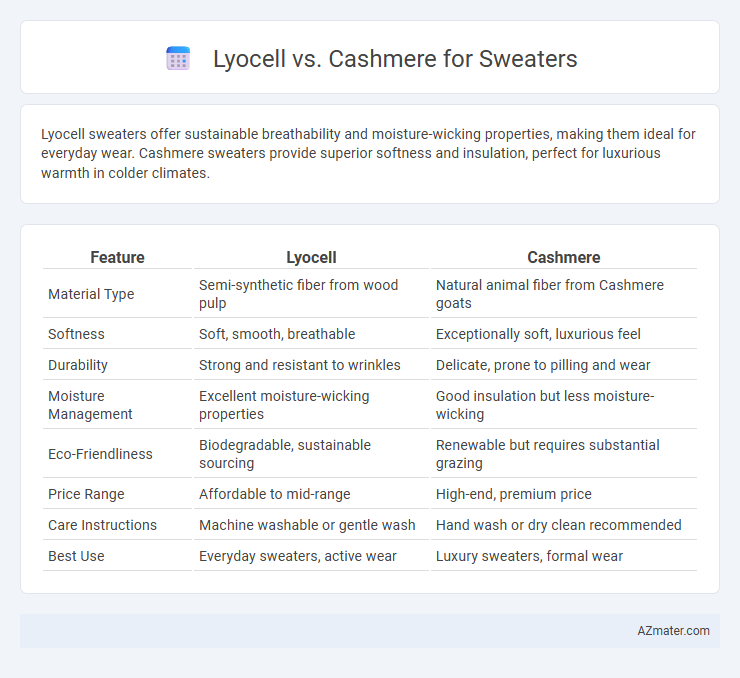Lyocell sweaters offer sustainable breathability and moisture-wicking properties, making them ideal for everyday wear. Cashmere sweaters provide superior softness and insulation, perfect for luxurious warmth in colder climates.
Table of Comparison
| Feature | Lyocell | Cashmere |
|---|---|---|
| Material Type | Semi-synthetic fiber from wood pulp | Natural animal fiber from Cashmere goats |
| Softness | Soft, smooth, breathable | Exceptionally soft, luxurious feel |
| Durability | Strong and resistant to wrinkles | Delicate, prone to pilling and wear |
| Moisture Management | Excellent moisture-wicking properties | Good insulation but less moisture-wicking |
| Eco-Friendliness | Biodegradable, sustainable sourcing | Renewable but requires substantial grazing |
| Price Range | Affordable to mid-range | High-end, premium price |
| Care Instructions | Machine washable or gentle wash | Hand wash or dry clean recommended |
| Best Use | Everyday sweaters, active wear | Luxury sweaters, formal wear |
Introduction to Lyocell and Cashmere
Lyocell is a sustainable fabric derived from wood pulp, known for its softness, breathability, and moisture-wicking properties, making it ideal for lightweight sweaters. Cashmere, sourced from the undercoat of cashmere goats, offers exceptional warmth, luxury, and a silky texture, prized for high-end, cozy sweaters. Both materials provide distinct benefits, with Lyocell emphasizing eco-friendliness and durability, while Cashmere highlights premium softness and insulation.
Fabric Origins and Production Processes
Lyocell, derived from sustainably sourced wood pulp, undergoes a closed-loop production process that minimizes environmental impact by recycling water and solvents. Cashmere originates from the fine undercoat of Cashmere goats, primarily harvested through combing during molting season, requiring meticulous handcrafting to ensure fiber softness and quality. The contrasting origins and production methods highlight Lyocell's eco-friendly, industrial scalability versus Cashmere's traditional, labor-intensive craftsmanship emphasizing luxury and warmth.
Texture and Feel: Lyocell vs Cashmere
Lyocell sweaters offer a smooth, silky texture with excellent breathability and moisture-wicking properties, making them soft and cool against the skin. Cashmere sweaters provide an ultra-lush, warm feel due to their fine, dense fibers, creating a luxurious, lightweight softness that retains heat effectively. While Lyocell excels in durability and a sleek finish, cashmere delivers unmatched plush comfort and warmth, ideal for cozy, high-end sweaters.
Warmth and Insulation Comparison
Lyocell offers moderate warmth with excellent breathability, making it suitable for temperature regulation in sweaters, while cashmere provides superior insulation due to its fine, dense fibers that trap heat effectively. Cashmere sweaters deliver exceptional warmth without bulk, ideal for cold climates, whereas Lyocell is more lightweight and moisture-wicking but less insulating. Choosing between the two depends on prioritizing either high thermal retention with cashmere or moisture management and comfort with Lyocell.
Breathability and Moisture Management
Lyocell offers superior breathability compared to cashmere, making it ideal for sweaters that regulate body temperature effectively. Its moisture-wicking properties efficiently draw sweat away from the skin, keeping the wearer dry and comfortable. Cashmere, while luxurious and warm, tends to retain moisture and lacks the same level of breathability, which can lead to overheating and dampness during extended wear.
Durability and Longevity
Lyocell offers superior durability and resistance to wear compared to cashmere, making it ideal for sweaters that require long-lasting performance and minimal pilling. Cashmere, while luxurious and soft, is more prone to fiber breakage and delicate care needs, which can reduce the longevity of sweaters over time. Sweaters made from Lyocell maintain structural integrity with frequent use and washing, whereas cashmere requires gentle handling to preserve its softness and lifespan.
Maintenance and Care Tips
Lyocell sweaters require gentle machine washing in cold water and air drying to maintain their softness and prevent shrinkage, while cashmere sweaters need hand washing or dry cleaning to preserve their delicate fibers and natural oils. Storing cashmere in breathable bags and avoiding direct sunlight prevents pilling and discoloration, whereas lyocell benefits from ironing on low heat with a cloth barrier to avoid fabric damage. Proper maintenance of both materials extends the durability and comfort of sweaters, ensuring long-lasting wear and texture retention.
Eco-Friendliness and Sustainability
Lyocell, derived from sustainably sourced wood pulp using a closed-loop process, offers excellent eco-friendliness with minimal water and chemical usage compared to cashmere, which involves intensive grazing practices that can lead to land degradation and overgrazing. Cashmere production often results in higher greenhouse gas emissions and biodiversity loss due to the environmental impact of goat farming. Choosing lyocell sweaters helps reduce ecological footprints through biodegradable fibers and sustainable manufacturing, while cashmere's luxury appeal must be weighed against its greater environmental costs.
Price and Value for Money
Lyocell sweaters typically offer excellent value for money due to their affordability and eco-friendly production, with prices generally lower than cashmere. Cashmere, known for its luxurious softness and superior warmth, commands a higher price point but justifies the cost through its durability and premium feel. Choosing between Lyocell and cashmere depends on prioritizing budget-conscious sustainability or investing in long-lasting, high-end comfort.
Choosing the Best Material for Your Sweater
Lyocell offers exceptional moisture-wicking properties and breathability, making it ideal for sweaters worn in various climates, while cashmere provides unparalleled softness and insulation, perfect for luxurious warmth during colder months. Choosing between Lyocell and cashmere depends on the balance you seek between durability, eco-friendliness, and plush comfort. Evaluating factors such as care requirements, price point, and intended use will help you select the best material for your sweater.

Infographic: Lyocell vs Cashmere for Sweater
 azmater.com
azmater.com